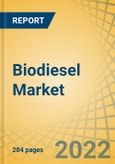The research report titled, ‘Biodiesel Market by Blend (B100, B20, B10, B5), Feedstock (Vegetable Oils {Rapeseed Oil, Palm Oil}, Animal Fats {Poultry, Tallow}), Application (Fuel {Automotive, Marine, Agriculture}), and Geography - Forecast to 2029,’ provides an in-depth analysis of the biodiesel market in five major geographies and emphasizes on the current market trends, market size, market shares, recent developments, and forecasts to 2029. In terms of value, the biodiesel market is expected to reach $51.47 billion by 2029, at a CAGR of 3.6% during the forecast period 2022-2029.
The growth of this market is driven by the increase in consumption of biodiesel, the rising environmental concerns, and the increasing demand for biodiesel to replace fuels in transportation and power generation. However, performance concerns in diesel engines are expected to hinder the growth of this market to a certain extent. Moreover, government support from North America, Latin America, Europe, and Asia-Pacific countries is expected to offer significant growth opportunities for players operating in the biodiesel market.
The global biodiesel market is segmented by blend type (B100, B20, B10, and B5), feedstock (vegetable oils, animal fats, used cooking oil (UCO), and others), and application (fuel, power generation, and others). The study also evaluates industry competitors and analyzes the regional and country-level markets.
Based on feedstock, the UCO segment is expected to account for the largest share of the global biodiesel market during the forecast period. The fast growth of this segment is mainly attributed to the increasing food service industry and the growing use of used cooking oil in the production process of biodiesel. Furthermore, the growing awareness about environmental welfare and sustainable energy resources and the high use of UCO in China and India is expected to spur the demand for UCO in biodiesel production.
Based on the application, the fuel segment is expected to account for the largest share of the global biodiesel market during the forecast period. The large market share of this segment is attributed to its increased use as fuel in automotive, agriculture, and marine industries, the rising environmental concerns, and the increasing pollution due to pollutants from petrol or diesel-based automobiles. Furthermore, biodiesel fuel is highly demanded in the automotive industry as it emits fewer greenhouse gases.
Based on geography, Asia-Pacific is slated to register the highest CAGR during the forecast period. The fast growth of the biodiesel market in Asia-Pacific is attributed to the increasing government blend mandates and environmental concerns over petroleum diesel usage. Furthermore, a growing preference for replacing fossil fuels related to higher greenhouse gas emissions is persuading the demand for biodiesels in these countries. Hence, with the increasing blend percentage in Indonesia, Thailand, Malaysia, and India, the Asia-Pacific region is expected to witness the highest growth rate during the forecast period.
Key Players
The key players operating in the global biodiesel market are Archer-Daniels-Midland Company (U.S.), Ag Processing Inc (U.S.), Avril Group (France), Biodiesel Bilbao S.L. (a subsidiary of Bunge Limited) (Spain), Cargill Inc (U.S.), Emami Agrotech Ltd (part of Emami Limited), FutureFuel Chemical Company (U.S.), G-Energetic Biofuels Private Limited (India), Louis Dreyfus Company (Netherlands), Münzer Bioindustrie GmbH (Austria), Renewable Energy Group (U.S), VERBIO Vereinigte BioEnergie AG (Germany), Wilmar International Limited (Singapore), and World Energy LLC (U.S.).Scope of the Report:
Biodiesel Market, by Blend
- B100
- B20
- B10
- B5
Biodiesel Market, by Feedstock
- Vegetable Oils
- Animal Fats
- Used Cooking Oil (UCO)
- Other Feedstocks
Biodiesel Market, by Application
- Fuel
- Power Generation
- Other Applications
Biodiesel Market, by Geography
- North America
- U.S.
- Canada
- Europe
- Spain
- France
- Germany
- Italy
- U.K.
- Netherlands
- Poland
- Austria
- Rest of Europe
- Asia-Pacific (APAC)
- China
- India
- Indonesia
- Thailand
- South Korea
- Malaysia
- Rest of Asia-Pacific (RoAPAC)
- Latin America
- Brazil
- Mexico
- Argentina
- Colombia
- Rest of Latin America (RoLATAM)
- Middle East & Africa
Key Questions Answered in the Report
- Which are the high-growth market segments in terms of blend type, feedstock, application, and region/country?
- What was the historical market size for biodiesel across the globe?
- What are the market forecasts and estimates for 2022-2029?
- What are the major drivers, restraints, opportunities, and trends for the global biodiesel market?
- Who are the major players in the global biodiesel market?
- How is the competitive landscape, and who are the market leaders in the global biodiesel market?
- What are the recent developments in the global biodiesel market?
- What are the geographical trends and high-growth regions/countries?
- Who are the local emerging players in the global biodiesel market, and how do they compete with the global players?
Table of Contents
Companies Mentioned
- Archer-Daniels-Midland Company (U.S.)
- Ag Processing Inc (U.S.)
- Avril Group (France)
- Biodiesel Bilbao S.L. (a subsidiary of Bunge Limited) (Spain)
- Cargill Inc (U.S.)
- Emami Agrotech Ltd (part of Emami Limited)
- FutureFuel Chemical Company (U.S.)
- G-Energetic Biofuels Private Limited (India)
- Louis Dreyfus Company (Netherlands)
- Münzer Bioindustrie GmbH (Austria)
- Renewable Energy Group (U.S)
- VERBIO Vereinigte BioEnergie AG (Germany)
- Wilmar International Limited (Singapore)
- World Energy LLC (U.S.)








